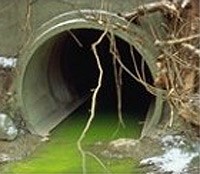"We Love to Manage Environment at Construction Projects - TechConsults
TechConsults efforts shall be for enhancing construction project management with the use of wisdom , knowledge and good practices tools and techniques , and by interaction in our BLOG section , supported by HSSE and TQM
SK Saxena PMP BE, MBA, FIE (India)
Environment management at Construction Projects HSSE 3 SK 18

Environment
Environment Impact Assessment
Types of pollutants
pH
pH diagram
Causes of pollutants
Environment Management Plans
Environment Management
Waste Generation Sources and Effluent Treatment
Prevention Measures to Check Water Pollution
Actions Required
Environment Indicators
Inspections Required
Construction Site Impacts on Environment
High Level Involvement
Weather Stations
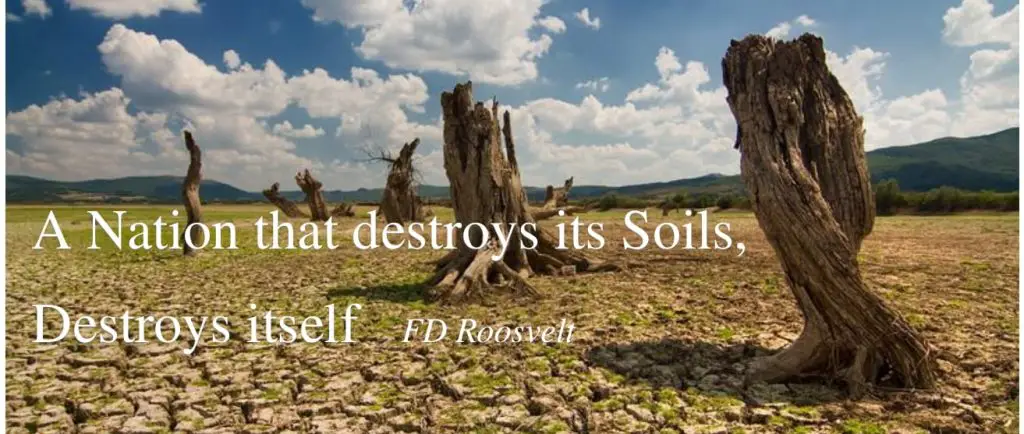
Environmen
Environment is the sum of all surroundings of a living organism, including natural forces, which provide conditions for development and growth, as well as of danger and damages.
Environmental factor or ecological factor or eco factor are responsible for maintaining the sustainability of life and natural forces. These are:
Ambient temperature,
Sunlight, and
pH of the water and soil
Availability of food for life
All the above factors, if disturbed and the balance in required conditions is not met, then the whole life process and the nature gets affected. All actions being done in development process throughout the world affects the land, the air and the water along with other environment factors mentioned above, and thereby affects the total life. There is need of sustainable development to counter such imbalances.
Environment engineering principles are applied in all construction and development works and utmost care is taken to control degradation of land, air and water.
Environmental engineering is the branch of engineering that uses the principles of science, technology and engineering, throughout the globe, for protection of life and nature from adverse impact on environmental factors. Environmental engineering system provide control measures for:
Energy Preservation,
Waste Management
Water Borne Diseases
Enforcement Measures
Water Management
Soil Management
Air Quality Management
Acid Rains
Global Warming
Ozone Layer
And many others
Environmental Impacts Assessment (EIA) and Mitigation
World is changing all the times with the development and advancement in technology. This changes the existing environment conditions which may not be desirable. Therefore, in any project for development, it is exercised how the development affects the environment and what shall be the mitigation measures for adverse impact. The EIA done, provides a foresight to Construction Agency and the stakeholders, to implement necessary controls and mitigation measures.
The development-action output is damaging to existing land, water and air, and their users (Humans and non-Humans) and as such, if not managed properly is harmful for sustainable development.
The assessment of requirements, the planning, the execution, the Monitoring & Control, the Feedback and Modifications must be judiciously done for development of HSSE Management System as suggested in TechConsult’s HSSE 1 SK 16 https://techconsults.in/health-safety-security-environment-at-construction-projects/ and should be earnestly implemented for a cost-effective project output
Types of Pollutants
There are two types of water pollutants from visibility point of view.
Which we can see (sediments, bed silt, suspended silt) and which we cannot see (dissolved solids, liquids and gases)
Every work site creates pollution such as from:
Excavation in soil or rock – sediments
Chemicals used in construction such as oils and Greece.
Effluent from workshops, blasting and other construction operations.
These pollutants reduce
Water clarity disturbs source of food and habitat inside the water and affects the life inside.
They carry Nitrogen and Phosphorus nutrients which helps in algal growth.
Reduces aesthetic value of flowing and non-flowing water.
Affects the quality of water for drinking and industry use.
Suspended silt makes the water turbid which increases virus and bacteria and reduced oxygen.
Non-visual pollutants (such as acids, lime, gypsum) can be dissolved in water or may remain in suspension, may settle on the bed and may go deep into the water level to meet the ground water and pollute the underground reservoir.
As such the after effects of the visual and non-visual pollutants are harmful to human in non-human. The contaminated water becomes unsuitable for drinking and construction purposes.
The water uses for domestic use specially for drinking may have adverse effect on the human life, if the quality of water is not good. The pH scale provides a general idea for quality of water for primary understanding. Also, readily available digital equipment proved instant quality status.
pH (potential of Hydrogen)
It is a measure of alkalinity or acidity of water at a given temperature.
Type of Solution | pH | Suitable range for surface water is 6.6 to 8’5Suitable range for drinking water is 6.0 to 8.5 | ||
Acidic | <7 | pH<6.5-water is acidic, sour in taste, water may contain Fe, Mn, Ca, Pb, Zn and is not fit for washing clothes | Hydrogen ion is more active | |
Neutral | 7 | pH of pure distilled water | Hydrogen and oxygen ion are equally active. | |
Basic or Alkaline | >7 | pH > 8.5 is hard water | OH, ion is more active |
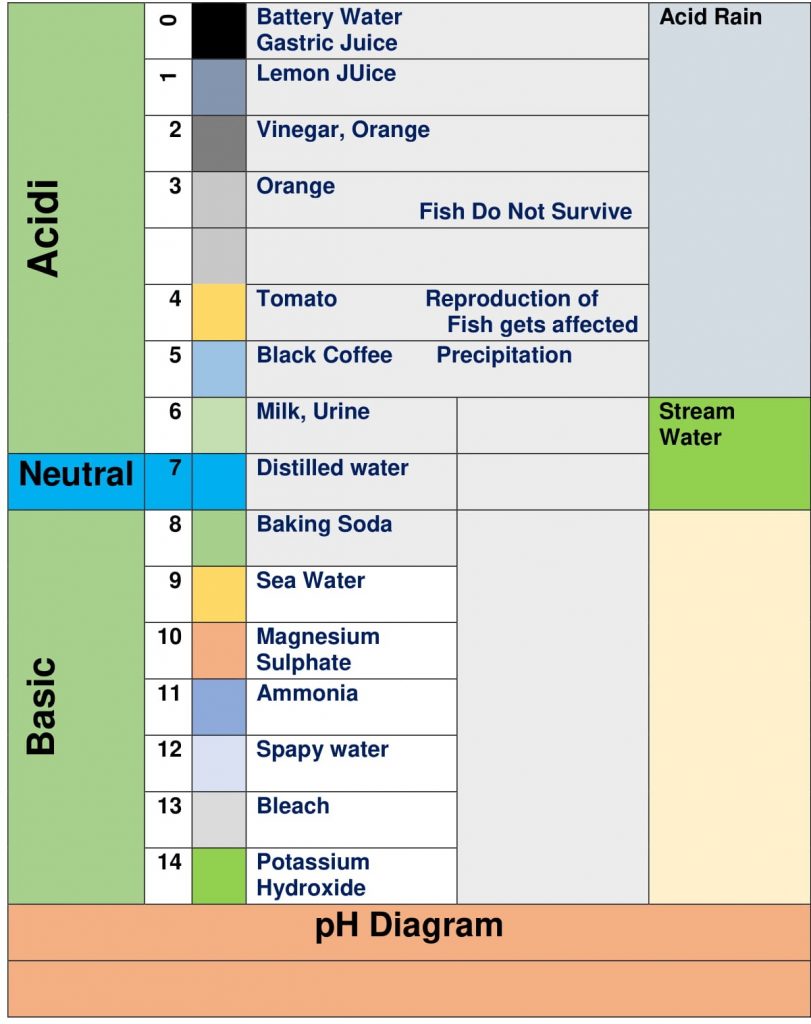
Causes of pollution.
Agricultural management require pesticide and fertilizer to get the crop output in right way and in required quantity. All pesticides and fertilizers are not used and remain in top soil. Fecal matter of animals and humans also remains in the top soil. These pollutants are washed away with rain water and travel through drains and streams to rivers. Also, sewage is a major pollutant contributor. The problem is more serious when the streams and rivers are not in stage. That is in the dry season.
Industrial waste
The type of waste depends upon the type of industry in which different type of chemicals are released during the manufacturing / processing period and the effluents from these industries find their way ultimately to rivers or the ground water.
Infrastructure development waste
The waste produced in construction projects from rural development to urban development to development in oil gas and energy sectors, contributes to pollutants, that affects the environment (land, air, water) and have direct impact on construction work force.
Medical Waste
It is waste created at clinics and hospitals at construction project sites. The quantity may be less and considering this, it becomes the part of normal waste. This practice is not desirable. Special category must be designated for this water disposal management in consultation with state medical units.
“If it can’t be reduced, reused, repaired, rebuilt, refurbished, refinished, resold, recycled, or composted, then it should be restricted, designed or removed from production.”
– Pete Seeger, Folk Singer & Social Activist
Environment Management Plans
Pollution Control
Restoration and Land Scape
Erosion and Sediment Control
Waste Management
Waste Water Management
Air Quality Management
Land Degradation Management
Traffic Management
Biodiversity Management
Emergency Preparedness and Response
Healthy, Safety Management Plan
Muck Management Plan
Environmental Management:
Water resources management
Continuous monitoring of the water resources utilization and quality is done. Daily logging / recording of borehole and surface water values at the abstraction points, and sprinkling records monitoring are also done and records. On the other hand, discharged water quality monitoring is done once in every month
Water Quality Monitoring
Water related diseases | Diarrhea, Dysentery, Cholera, Typhoid, Hepatitis, Guinea worms, Eye diseases, Skin diseases, |
Summary of Water Quality indicators | |
Indicators | Parameters |
Radioactive | Alpha, Beta and Gamma radiation emitters |
Biological | Bacteria, Algae |
Aesthetic | Color, Odor. Organic floating matter |
Physical | Temperature, Turbidity, Dissolved solids, color, salinity, suspended solids, dissolved solids |
Chemical | · pH DO (dissolved oxygen), BOD (biological oxygen demand), Nutrients (including N & P), organic and inorganic compounds, COD |
Waste generation source, and processes involved in effluent treatment
The existing water sources particularly in lean periods need to be checked for quality aspects, frequently, and after getting the results, a through planning and process execution must be decided so that the domestic needs, the agriculture needs are fulfilled, and water quality is safe so as not to harm the concrete and steel used in construction.
Waste generation source, and processes involved in effluent treatment
The existing water sources particularly in lean periods need to be checked for quality aspects, frequently, and after getting the results, a through planning and process execution must be decided so that the domestic needs, the agriculture needs are fulfilled, and water quality is safe so as not to harm the concrete and steel used in construction.
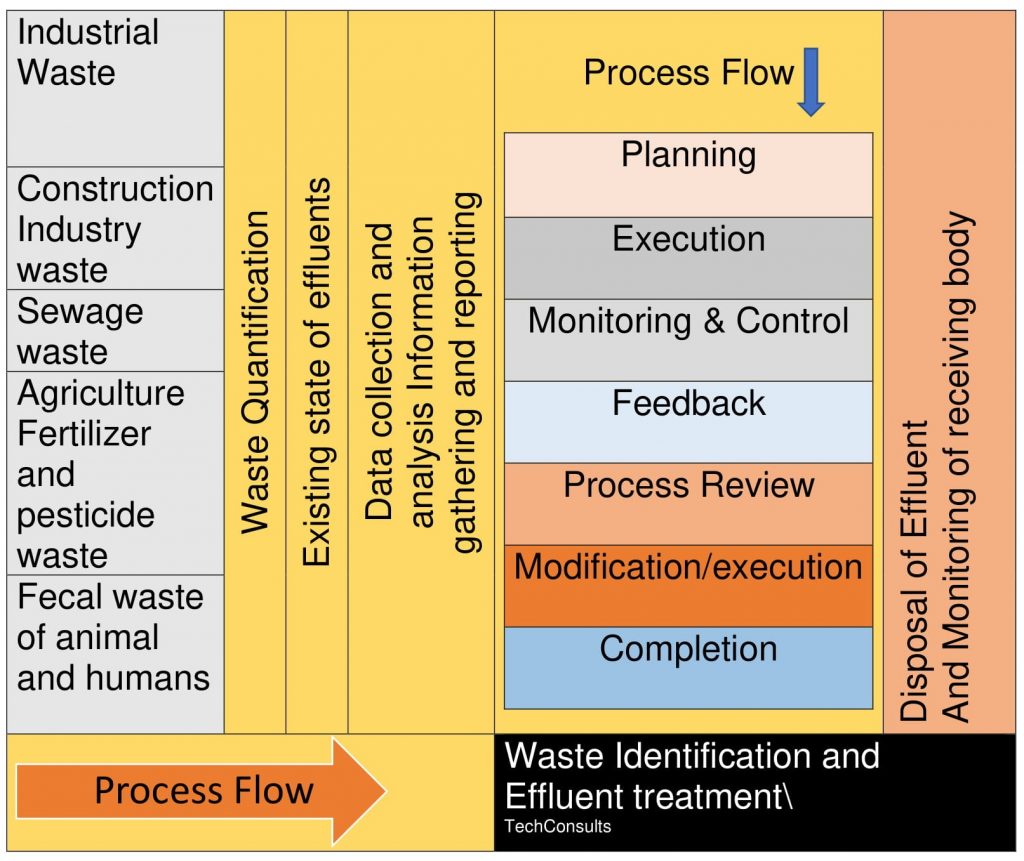
The Action of poor quality of water on Construction outputs
(please refer to TechConsults blog post
Water Quality for Consumption & Construction — Part 2
https://techconsults.in/water-quality-for-consumption-construction-part-2/
Water Quality for Consumption & Construction——— (part 1)
https://techconsults.in/water-quality-for-consumption-construction-part-1/ )
After effects of polluted water:
If consumed for drinking water needs, human and non-humans can suffer from water borne diseases such as Typhoid, Cholera, Diarrhea, TB, Jaundice, etcetera.
Organic matter present in water during its bio degradation process consumes oxygen, which reduces BOD of water. Low oxygen availability is harmful for aquatic life.
The organic matter from sewage and industrial effluents, provide nutrients to water bodies and drains. This increases plant life, decreases oxygen, and as such affects aquatic life.
TDS (Total Dissolved Solids)- If TDS > 500mg/liter may pass into blood there by reaching all parts of body affecting the functionality of the system. Also, in agricultural use of water, such dissolved solids, deposit inside the top soil after evaporation. These solids damage the fertility of the soil. Toxic pollutants (heavy metals, pesticide, xenobiotic pollutants (a substance that is not normally expected) are harmful to use.
Prevention measures to check water pollution are required to reduce impact on health, environment, and to manage water safety standards.
Water sprinkling
The project construction works are open to traffic used for construction and for the movement of machines such as the earth moving machines. The movement of the traffic creates dust nuisance thereby polluting the air and is a major source of health hazard. As such continuous sprinkling of dust creating areas should be done.
Waste Management
Waste of oils and lubricants should not be allowed to drain out in earth or streams
The waste from toilets should go to sewage treatment plant and should be disposed only after the disposal criteria is followed.
The food waste must be sorted out in types of biodegradable and non-biodegradable wastes
Biodegradable waste can be treated by covering it with earth and watering. This may be done in layers. Earth worm use it and convert it into good fertilizers which may be used for agriculture.
Non-biodegradable waste specially of plastics should be collected, shredded for recycling.
The waste disposal site should be kept covered, with proper drainage all around. This is the place where the waste is primarily dumped first before sorting.
Muck Management:
Excavation is a voluminous activity at most of the construction projects and is taken out from over the ground and under the ground.
In both cases the excavated earth / rock should me managed properly by maintaining a muck management plan and controlling the muck disposal operations.
Following are some of the important points to be considered.
Assess the Quantity of muck disposal.
Mark the disposal sites on the map and get its approval.
Construct and maintain haul roads from excavation to disposal site.
Water the haul roads to avoid dust control.
Spread muck in layers in the desired area within the height limits.
The rock muck is used at crushing and processing plants to get different size aggregates for construction needs. This operation needs watering of the aggregates for washing and avoiding dust nuisance. Sedimentation tanks must be used for treatment of this muddy water. And only thereafter clear water must be disposed to streams, water bodies or river.
Dust creating plants must have:
Dust catchers and removers. Such collected dust laden water must be disposed through settling tanks.
Greenery in the area must be developed.
Provide water sprinkling system in the plants
Provide metaled roads in the area
Wind breakers should be provided.
Equipment and vehicles used must follow latest technology norms
Temperature of the effluents must not be higher by 5 degree centigrade with respect to receiving body temperature.
Biodiversity Monitoring:
In far off project areas near protected forests there may be requirements of reporting details about the following:
Status of water bodies including their number, spread, and effect of project construction on them (how biodiversity gets affected).
Status of wild animals on the project site (may include their attacks on project workforce) and effect of project on the wild life (How project activities have affected their spread in the area and how many encounters done with animals and with what results)
How project construction has affected the waters of stream, waterbodies, and river with respect to water quality and life in and around such water sites. (the quality data must be monitored with a baseline data prepared for area affected by the project.)
The above data must be maintained during the project period at intervals required for proper monitoring and control
Actions Required
The effluents from the surface treatment plants, construction sites, industries need to be treated with best available technology and tested with digital instruments. Air quality monitoring must be done weekly or as required in underground works depending on the work operations. (Real time monitoring mechanisms are better)
Noise level monitoring is done weekly or on the scale of operations
Sedimentation tanks cleaning and sediment disposal
Measuring of effluent discharge into the river
Water, soil and effluent sampling and testing
The technological upgradation must be taken on priority.
All actions must be based on quality plans and assurance measures, predetermined to the satisfaction of standard requirement.
The Quality Control feedback, and the modifications on the feedback, if required must be done immediately.
Standard laboratories with latest equipment and technology must help in testing the quality of effluents.
The receiving bodies quantity capacity and quality capacities must be ascertained before allowing disposal into them.

‘The simplified technology use’ properly standardize must be enforced by awareness creation and mandatory laws.
The discharges from tannery, textile, paper, plastics, petrochemical and food processing mills, and other pollutants creating units must be checked for COD and BOD, before and after effluent treatment.
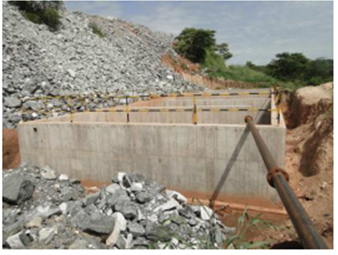

The construction project road stabilization and sediment control measures must be taken timely.
Please refer to Blog Q2 SK 10 on Water Quality for consumption & Construction.
Environmental Indicators:
Environmental indicators are simple measures that tell us
What is happening in the environment? These are:
Substances Recycled
Water Abstraction Records
Waste Disposal
Muck Managed
Wild Life Displaced
Water Quantity Sprinkled
Wild Life Added
Air quality monitoring at different workplace
locations
Water quality data with respect to baseline
Number of Wild life encounters
Number of animal species encountered
Total amount of waste generated (kg)
Amount of biodegradable waste (kg)
Amount of Inorganic waste collected (kg)
Amount of waste recycled (kg)
Number of incidents observed/ reported
Total mileage covered by vehicle fleet
Total volume of water used by project
Amount of aggregates collected after crushing of rock
Total quantity of muck managed
And more as per project needs
List of Inspections to be taken up at construction projects (may be customized to project need)
Muck management Inspection
Sampling at site -all categories
Stakeholder engagement
Legal enforcement follows up
Planned action follow up
Processing plant inspection
Noise and air quality assessment
Traffic volume and speed records
Sedimentation tank inspection
Haul road management Inspection
Waste awareness promotion
Wild encounter recording
Daily water abstraction records
Oil slippage monitoring
Investigating and tracing for Suspected Wild animal, if available in project area
Basting Vibration Monitoring
Nose monitoring inside the tunnels
Impact of construction sites on environment:
The construction sites over the ground or under the ground excavation operations creates pollutants in the form of, blasting dust and chemicals, natural chemicals and gases, machines oils and lubricants, effluents gases. The harmful contents obtained from construction operations when exceeds the safety limits are detrimental for human health and for water quality.
Construction site water pollution control mechanisms:
Sediment control in effluents-This is done by draining the sediment laden site area water into sedimentation tanks of designed capaciti
Water should be allowed to drain out only after sedimentation has taken place. Important locations such as tunnel portals and aggregate processing plants and batching plants etcetera are some of the locations where sedimentation tanks are to be provided.
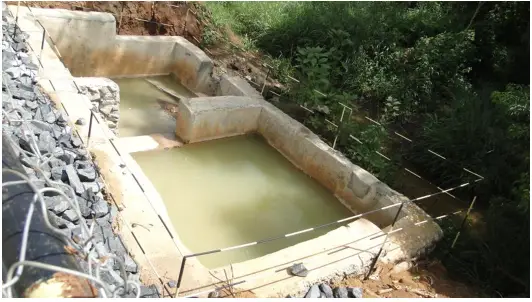
It is necessary to manage construction activities as per specifications, and strict monitoring and controls are to be provide.
Take all necessary steps for pollution control of air water and land areas associated with construction project.
Follow up of environment control / management Act.
Biodiversity maintenance norms and construction project specifications, policy and procedures decided along with necessary control measure must be followed in totality.
Mange the storm water drainage, project roads management, by controlling the inflow of pollutants in drains and sprinkling roads with water at desired interval.
Follow the machine and equipment use procedures.
Implement the system for optimum and required use of the equipment to check pollutants generation.
Necessary test and control measures should be taken by site construction units, supervision units and third-party checks.
Maintain proper documentation, for operating procedures of machine and equipment, used in construction works. Audits and Inspection of the work should be done as per standard requirements.
Administration of contract as per contact document is necessary, along with other support requirements of contract provisions.
Awareness creation should be given priority. A sincere effort in awareness creation, and it follow up to requirement, makes a big difference.
On site instructions during pre-construction stage, during construction stage and post construction stage should be displayed for every activity related to pollution control.
Quality control team should provide necessary feedback and issue Notices for Non conformance. There should be regular testing, monitoring, reporting, and discussions, on control measures.
The most important steps taken at the higher levels are:
The clearly and coordinate based site map of construction project, that fulfill the requirements, should be handed over to the construction agency (CA).
The CA must keep the project area fenced with gates, for safety and security. The activities areas inside the occupied areas should be marked and the maps should be revised periodically based on the pace of development inside the area.
All the stakeholders should participate in providing support to mandatory control measure
Construction of check dams on natural drains and streams, help in creating low velocity of water, which provides more settling time to particles and checks flow of sediments.
Check dams provide more time to store water and, the water percolates to recharge the ground water.
Check dams can increase the ground water table in river basins.
City sewage must be treated in sewage treatment plants and only treated effluents be allowed to join the river.
Coliform exists in the bodies of warm-blooded animals and humans. And are passed out as fecal matter in environment. Their availability in water test samples results, indicate that the water was in contact with fecal waste and as such may contain disease causing organisms.
Real time data collection and monitoring system are in place in this age of advanced computer and data transmission technology. Weather Station data is also available. All such data can be analyzed foe meaningful information which can be used for pollution control of effluents.
Weather Monitoring
Weather monitoring station is a requirement at the project areas to assess the changes during and after construction of projects. Also, this data helps construction agencies and organizations to plan the required activities as they get a clear status of the environment. The data also helps to resolve construction related issues raised by the Construction Agencies during project operations. The data may be monitored in the below mentioned format:
Weather Monitoring formatDate | Rainfall | Temperature℃ | Humidity (%) | |||||
Max | Total | Max | Min | Average | Max | Min | Average | |

